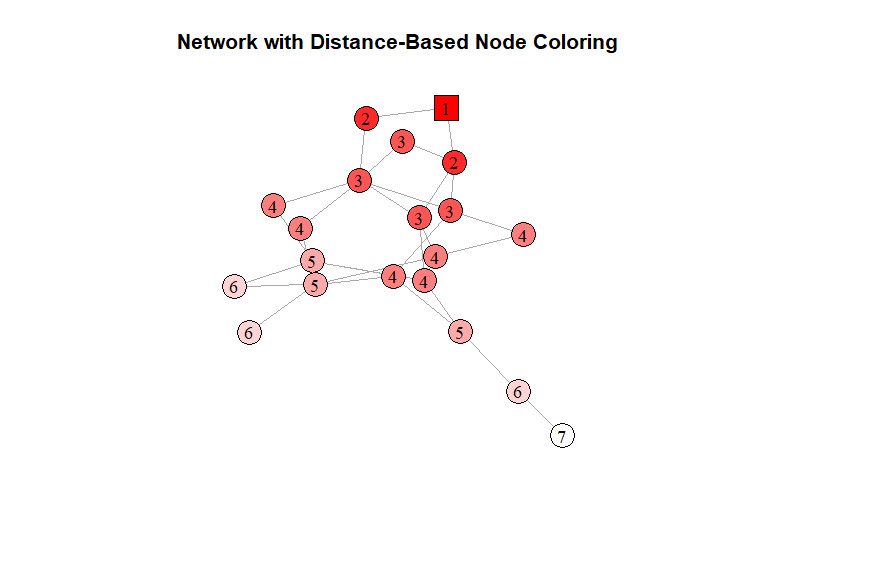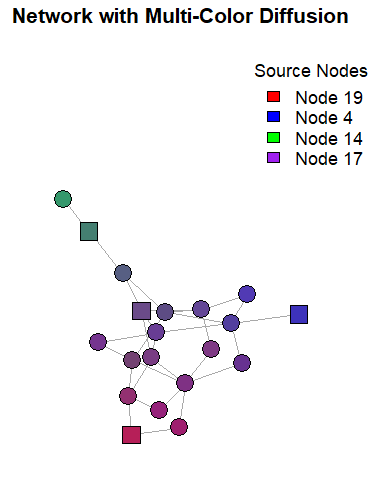I have a random graph in R in which one random node is colored red (square) - and all other nodes are colored lighter shades of red relative to their distance from the original node (i.e. based on "degree"):
library(igraph)
library(colorRamps)
set.seed(123)
n_nodes <- 20
n_edges <- 30
g <- erdos.renyi.game(n_nodes, n_edges, type = "gnm")
random_red_node <- sample(1:n_nodes, 1)
distances <- distances(g, v = random_red_node, to = V(g))
max_distance <- max(distances)
color_palette <- colorRampPalette(c("red", "white"))(max_distance + 1)
node_colors <- color_palette[distances + 1]
node_colors[random_red_node] <- "red"
node_shapes <- rep("circle", n_nodes)
node_shapes[random_red_node] <- "square"
node_labels <- distances + 1
par(mar = c(5, 4, 4, 8), xpd = TRUE)
plot(g,
vertex.color = node_colors,
vertex.size = 15,
vertex.label = node_labels,
vertex.label.color = "black",
vertex.shape = node_shapes,
vertex.frame.color = "black",
edge.arrow.size = 0.5,
main = "Network with Distance-Based Node Coloring")
I am trying to change this so that now I can have multiple square nodes of different colors, and the same fading is applied:
The idea is to mimic diffusion of colors such that they create natural boundaries.
Thank you.
Here is a question that might help: How to tell if a point has been colored twice in R?
edit: My approach - this only works for a few nodes and will not work for multiple source nodes of the same color (e.g. multiple reds)
First, I use a function to define the color gradients:
library(igraph)
library(colorRamps)
set.seed(123)
blend_colors <- function(colors, weights) {
if (length(colors) != length(weights)) stop("")
rgb_colors <- col2rgb(colors)
blended <- rowSums(rgb_colors %*% diag(weights)) / sum(weights)
rgb(blended[1], blended[2], blended[3], maxColorValue = 255)
}
I then generate a network for the problem:
n_nodes <- 20
n_edges <- 30
g <- erdos.renyi.game(n_nodes, n_edges, type = "gnm")
n_colored_nodes <- 4
colored_nodes <- sample(1:n_nodes, n_colored_nodes)
node_colors <- c("red", "blue", "green", "purple")[1:n_colored_nodes]
The fading is a function of distance, I tried to capture this idea:
distances_list <- lapply(colored_nodes, function(node) {
distances(g, v = node, to = V(g))
})
max_distance <- max(unlist(distances_list))
normalized_distances <- lapply(distances_list, function(d) {
1 - (d / max_distance)
})
Here is how I call this :
blended_colors <- sapply(1:n_nodes, function(i) {
weights <- sapply(normalized_distances, function(d) d[i])
blend_colors(node_colors, weights)
})
node_shapes <- rep("circle", n_nodes)
node_shapes[colored_nodes] <- "square"
par(mar = c(5, 4, 4, 8), xpd = TRUE)
plot(g,
vertex.color = blended_colors,
vertex.size = 15,
vertex.label = NA,
vertex.shape = node_shapes,
vertex.frame.color = "black",
edge.arrow.size = 0.5,
main = "Network with Multi-Color Diffusion")
legend("topright", inset = c(-0.2, 0),
legend = paste("Node", colored_nodes),
fill = node_colors,
title = "Source Nodes",
bty = "n")





